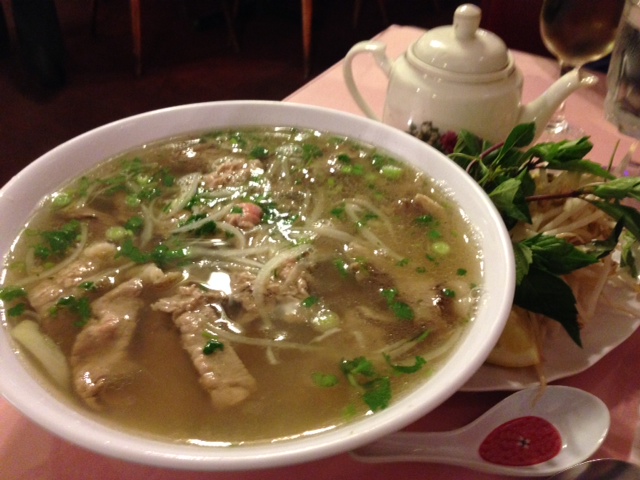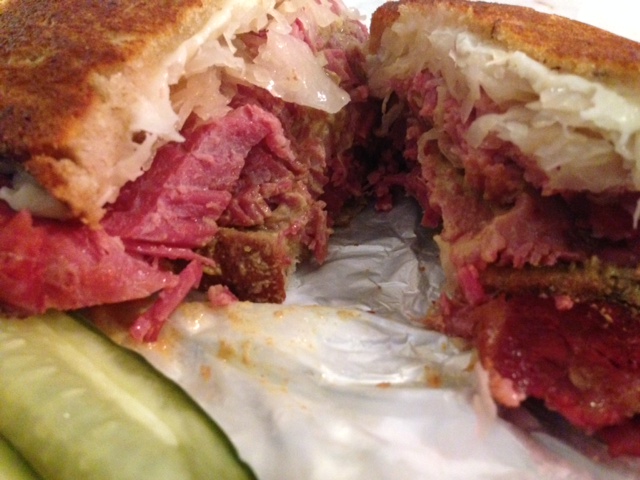An ode to stinky cheese
A cheese-and-fruit platter is a simple, but classic after-dinner course, and a perfect addition to any potluck/dinner party. Tradition dictates serving three types of cheese with fruit after dinner: a soft cheese, a hard cheese and a blue cheese. When it comes to stinky cheese, the latter is what comes to most peoples’ minds. But we remember one dinner party we threw for some of our TCD friends a while ago when we served nice big hunks of soft French Camembert, hard Dutch Gouda and English Blue Stilton with mixed grapes, and the uncovered Camembert quite unexpectedly out-stank everything in the house!

A ripe Camembert pairs nicely with champagne. Photo by Grongar via Flickr creative commons
Skip’s suggestion – Camembert: This soft and fragrant cheese can be almost as problematic as blue cheese, especially when served ripe. So the pairing does depend quite a bit on the ripeness of the cheese. When young, itʼs mellow and buttery but as it ages it develops an earthy pungency of mushrooms. As with Brie, Champagne and other sparking wines seem to hold their own pretty well. You could also try an old world style Chardonnay, meaning un or imperceptibly oaked, like a Pouilly-Fuisse from Burgundy.
Perhaps with the exception of French Roquefort (which, we admit, stinks a little), the stinkiest of cheeses do not appear to be blue-veined, but instead are the pale cream or white variety, like Brie. If you’ve ever had the unfortunate experience of tasting pale-colored Limburger, a product of an area of Europe that was once the Duchy of Limburg (which used to be located in parts of the Netherlands, Belgium and Germany), then you know what we mean.
Skip’s suggestion – Limburger: Pairing this obnoxiously pungent cheese practically qualifies for a Fear Factor challenge. But like a lot of stinky foods, itʼs bark is worse than itʼs bite, and the taste and creamy texture are quite remarkable.
Now for the reality. Limberger cheese is too overpowering to pair with wine. Traditionally itʼs served with lager beer or strong coffee. But if you insist on eating it with wine on the side, my best suggestion is to make it really cheap wine you buy for the sexy label.
It would seem that hard cheeses are not found among the stinky cheese of the world. Italian Parmigiano Reggiano is about as hard as a cheese gets, and it smells divine. Spanish Manchego cheese, made from sheep’s or goat’s milk, is about the stinkiest hard cheese we can think of, but it doesn’t stink-stink. Rather, it just has a strong, yet appealing odor to it.
Skip’s suggestion – Manchego: Hard cheeses can be perfect partners for red as well as white wine. Manchego is a favorite of mine and an ideal cheese for wine. To keep it simple (but, to paraphrase Einstein, no simpler), pair it with a Spanish Rioja or another medium-bodied red from nearby, such as a Barbera or a Beaujolais-Villages.
Now, blue cheese looks like it should stink, right? But it seems that blue cheese only stinks according to one’s preferences for it. While Mrs. M. is not a fan, Mr. M. positively loves all varieties of blue cheese. Mrs. M. insists that most types of blue cheese stink. Mr. M., however, insists that most, if not all forms of blue cheese smell absolutely inviting. Curiously, we both like Camembert very much, and both agree that it stinks to high heaven.
Skip’s suggestion – Stilton: Because this blue cheese can be so powerful and so salty, it needs something very sweet and strong. Dessert wines such as Port and Sauternes are a time-honored match, and for good reason. Having said that, how many of us are readily drinking either? I know Iʼm not. So most times, if thereʼs blue cheese around I just drink the wine I want a few minutes before or after eating the cheese. (If you canʼt taste the wine, you didn’t wait long enough.)
Let’s face it, cheese is weird. And though this weird foodstuff is primarily of European origin, mellow forms of cheese have been created by other cultures in a few other parts of the world, like the Mid-East and India. We wonder what it is about European cultures that led them to what is, in fact, a gastronomic horror story. The reality of cheese — curdled milk infested with microbial life forms — should exponentially deter people from wanting to eat it the more “fragrant” it is. But, as is the case with our blue-cheese preferences, to each their own!
Mr. & Mrs. M.’s Indian Paneer (home-made Indian cheese)
Recipe yields 1 pound (enough for 2 main servings or 4 side-dishes)
If stinky cheese isn’t your thing, try out this easy-to-make recipe for Indian paneer, a mostly odorless and mild cheese, which is a traditional component to many classic Indian dishes. By adding a tablespoon of salt to this recipe and replacing the vinegar with lemon juice, you can also make classic Mexican queso fresco (but do not use a coarse salt, like kosher, for queso fresco).
Skip’s suggestion – Indian cuisine: It’s nearly impossible to pair wine with the strong, fragrant flavors of Indian food, so forget the vino – drink beer!
INGREDIENTS:
½ gallon (4 pints) whole milk (may use 2% if you like)
½ cup vinegar – use a good white wine vinegar!
1 tsp. ground white pepper
PREPARATION:
Pour the milk into a large, deep pot; mix it well with the pepper (and salt, if using salt to make queso fresco). Gradually bring it to a boil over medium-high heat (keep a close eye on it so as to prevent it from over boiling over). Stir occasionally. When the milk starts to boil and begins to rise in the pot, cut off the heat and add the vinegar (or lemon juice), stirring until the mixture separates into solids and liquid.
Drain the mixture through a cheesecloth-lined colander or sieve set over a large bowl. Wrap the ends of the cheesecloth around the curd and put a heavy weight on it such as a cookie jar or other container.
Place the mixture in the refrigerator and let the water completely drain for at least one hour, or overnight for a firmer cheese.
Remove the paneer from the cheesecloth and use it immediately — it can remain refrigerated in a covered container for up to five days.
Indian Palak Paneer (spinach & cheese dish)
Makes 2 to 4 servings
This classic Indian dish combines fresh spinach and the cheese from the recipe above to make a creamy curry. It is traditionally served with basmati rice and Indian flat bread. Don’t be afraid of the spices – you can find all of them at any Indian grocery in the Greater-Milwaukee area!
INGREDIENTS:
6 tablespoons ghee (clarified butter) *may substitute any kind of cooking oil
2 cloves garlic, finely chopped/minced (or two teaspoons Indian garlic paste)
1 tablespoon grated fresh ginger root (or one tablespoon of Indian ginger paste)
2 whole dried red chili peppers
1/2 cup onion, finely chopped
2 teaspoons ground cumin
1 teaspoon ground coriander
1 teaspoon ground turmeric
3/4 cup sour cream
3 pounds fresh spinach, torn
1 large tomato, quartered
fresh coriander leaves to taste
8 ounces paneer cheese, cut into 1” cubes
salt to taste
PREPARATION:
In a large saucepan, heat three tablespoons of the ghee (or oil) and sauté the garlic, half of the ginger, the red chilies and the onion until nicely caramelized. Mix in the cumin, coriander, turmeric and sour cream (adding more or less so that it’s as creamy as you like). Add the spinach by the handful until it’s all cooked down. Remove the pan from the heat and allow the mixture to cool down a bit.
Pour the mixture into a food processor and add the tomato with the remaining ginger and the coriander leaves. Blend until the spinach is finely chopped, then pour back into the pan and keep it warm over very low heat.
In a medium-sized frying pan, heat the remaining ghee or oil over medium heat; fry the cheese cubes until they’re nicely browned. Lift the cubes out of the oil with a slotted spoon or basket ladle, and add to the spinach.
Cook for 10 minutes on low heat, then season with salt to taste.
Dining
-
Story Hill BKC Has So Many Menus
 May 27th, 2024 by Cari Taylor-Carlson
May 27th, 2024 by Cari Taylor-Carlson
-
Ouzo Café Is Classic Greek Fare
 May 23rd, 2024 by Cari Taylor-Carlson
May 23rd, 2024 by Cari Taylor-Carlson
-
Anmol Is All About the Spices
 Apr 28th, 2024 by Cari Taylor-Carlson
Apr 28th, 2024 by Cari Taylor-Carlson
Mr. and Mrs. M.
-
Phan’s Garden Is a Vietnamese Favorite
 Apr 30th, 2014 by Jeffrey Merlot
Apr 30th, 2014 by Jeffrey Merlot
-
Brr! Dishcrawl Was Freezing But Delicious
 Feb 13th, 2014 by Jeffrey Merlot
Feb 13th, 2014 by Jeffrey Merlot
-
Jake’s Deli is Deliciously Old School
 Feb 11th, 2014 by Jeffrey Merlot
Feb 11th, 2014 by Jeffrey Merlot


























